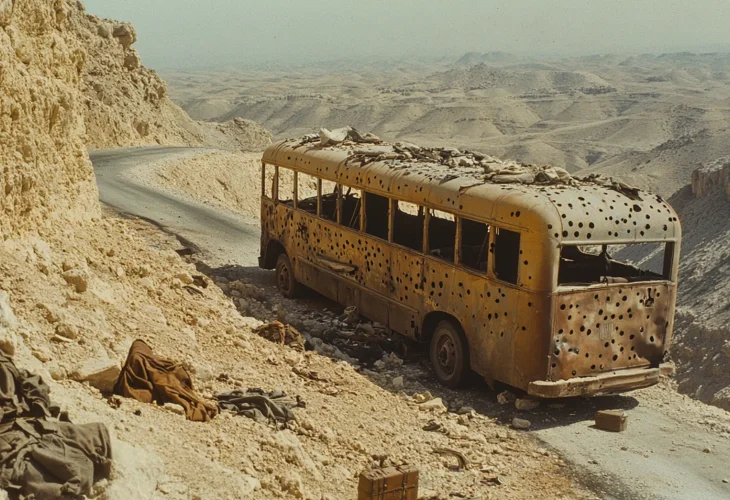History and Archaeology
The Ma'ale Akrabim Massacre: A Nation’s Early Tragedy
In 1954, terrorists ambushed a bus near Eilat, leaving a deep scar on Israel’s young history

The city of Eilat was the last area to be captured in Israel’s War of Independence. On the 9th of Adar 5709 (March 1949), Operation Uvda ended with the capture of the Negev and the Umm Rashrash police station, the site where Eilat now stands. The soldiers who reached it had no Israeli flag, so they drew one on a white sheet, the famous “ink flag” and raised it high.
Seventeen years later, on the 9th of Adar II, a large ceremony was held north of Eilat to mark the anniversary. In honor of the occasion, an enormous Israeli flag was displayed, 200 meters long and 100 meters wide, recognized by the Guinness Book of Records as the world’s largest. But our story takes place five years after that original flag-raising, during celebrations in Eilat.
On the 12th of Adar 5709 (March 1954), an Egged bus left Eilat for Tel Aviv. There were 11 passengers and four soldiers on board, the soldiers traveling to provide security. The road to Eilat back then was not the modern Arava Road we know today. It wound through the desert, passing steep, narrow curves, including the treacherous Ma'ale Akrabim, the “Scorpion Ascent” — a place mentioned in the Bible as a border point. There, hidden attackers waited in ambush. This would become the first massacre of Israeli civilians in the young state’s history.
As the bus reached Ma'ale Akrabim, gunfire erupted. The attackers aimed for the driver, hoping to send the bus plunging into a ravine. But the driver, Kalman Eshroni, though shot, managed to bring the bus to a stop. He even opened the doors so passengers could escape. The terrorists opened fire on the fleeing passengers, then boarded the bus to finish their attack.
The soldiers on board were armed, but caught off guard, they had no chance to fire before being killed. The substitute driver, Ephraim Firstenberg, tried to return fire, but he too was killed. The commander of the attack, Said Ibn Bandak, moved methodically, making sure no one was left alive.
Yet, miraculously, there were survivors. Five-year-old Miri Firstenberg, the substitute driver’s daughter, lived because the body of a soldier shielded her from the bullets. Her nine-year-old brother, Chaim, was shot in the head and survived, but was left paralyzed until his death in 1986, making him the 12th victim of the attack.
Not long after, a military jeep passed by. The soldiers inside, afraid the terrorists might still be present, drove away. They were later punished by the IDF for abandoning the scene. Only when the head of the Egged bus station in Be’er Sheva realized the bus was overdue did he send out a search. He found Miri and three other wounded survivors, rescuing them from the horror.
The Israeli government decided to photograph the bodies as they were found, to show the world the brutality of the attack. The killers had crossed from Jordan, and Israel demanded the Armistice Committee condemn Jordan. The committee refused, sparking anger throughout the country. To lift the nation’s spirits, the Prime Minister asked a popular singer to compose an upbeat song.
In the days that followed, a retaliatory operation led by Ariel Sharon targeted Jordanian National Guard and Arab Legion forces. Many years later, on November 10, 1968, a Shaked Patrol unit in Sinai encountered a terrorist cell and killed its leader, the same Said Abu Bandak who had commanded the Ma'ale Akrabim massacre.
Miri Firstenberg went on to live a long life. Tragically, her family was struck by terror again when her grandson’s wife was murdered in the Simchat Torah massacre of 2023. Speaking in an interview, Miri said, “They acted the exact same way as seventy years ago.”

